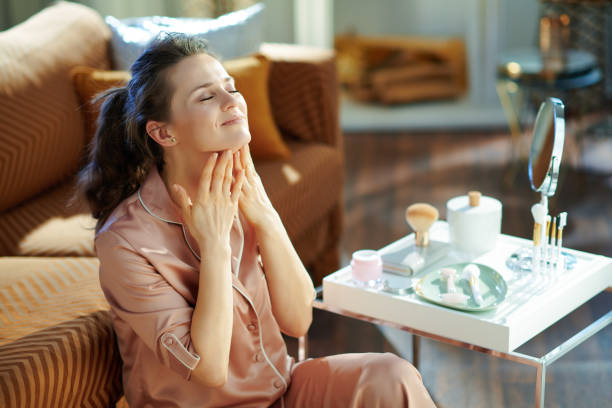Facing Down Acne: Separating Science from Myth

Let’s start by being brutally honest. Those that suffer from acne hate it with a passion, and for a good reason. It’s unsettling, annoying, and can be downright painful. It also can cause tons of issues like scarring that sticks around for years after acne has left the building.
And to make matters worse, there are a plethora of articles, journals, and home remedies that do nothing but serve to obscure the facts surrounding acne and effective treatments. So, let’s cut through the noise and try to get to the bottom of what causes this common skin condition and the best weapons to defeat it!
Types of Acne and How to Identify them

Acne is one of the most common skin issues, affecting nearly 50 million Americans regularly. Typically associated with fluctuations of hormones during teenage years, acne is not always isolated to teens or young adults. In fact, this skin issue can continue well on into adulthood.
But not all acne is the same! There are two acne varieties, each with its own set of subtypes. Let’s look at these types and how they materialize on the skin.
1. Non-Inflammatory Acne
The non-inflammatory acne variety often includes blackheads and whiteheads. These symptoms won’t always cause pain and inflammation and typically respond well to over-the-counter medications.
2. Blackheads
Blackheads appear when a pore becomes clogged with sebum and dead skin cells. Even though the pore is clogged beneath the surface, the top of the pore remains open to the air, resulting in a visually distinguishable black spot on your face.
3. Whiteheads
Unlike blackheads, these pesky actors form when a pore becomes wholly obstructed above and beneath the surface. This creates a telltale white bump that slightly protrudes from the skin.
Since whiteheads operate in a closed-cell manner, they can prove challenging to treat. Products containing astringents like salicylic can provide decent results. Topical retinoids are also an effective means of treatment.
4. Inflammatory Acne
When most people think of acne, they likely visualize the inflammatory type. This variety of acne causes red, swollen bumps that appear on your skin. Dead skin and sebum, an oily substance secreted to maintain flexibility in hair follicles, conspire to block pores, allowing bacteria to develop into an infection.
5. Papules:
Papules form when the edges of your pores break down from severe inflammation. This condition causes hardened, reddish-colored pores that are often tender to the touch.
6. Pustules:
Pustules are like papules in many respects, but pustules tend to fill with pus, forming large painful bumps. These bumps are typically red with white or yellowish caps.
7. Nodules
Nodules appear when clogged pores become increasingly irritated, growing large bumps that show up deep beneath the skin’s surface. With these being so deep in the skin, they are often difficult to treat with over-the-counter medications and require prescriptions to combat.
9. Cysts
The dreaded cyst! Cysts develop deep beneath the skin when pores become clogged by oil, dead skin, and debris. These bumps can grow incredibly large and cause severe pain and even scarring.
Identifying Mild Acne
Those that notice three or more bumps appearing on their face weekly are likely suffering from mild acne. And it’s possible to identify acne without the need for a doctor. You know your body better than anyone! But for a complete diagnosis and an accurate treatment plan, you will want to consult with a dermatologist.
Your doctor will ask you for details surrounding your breakouts and medical history to determine what types of acne you have and the best treatments for each of them. Milder cases can often be treated at home with over-the-counter remedies, but significant acne will most likely require prescription intervention.
Facing Down Acne
Acne is a common skin condition that affects millions of people all around the world daily. Virtually everyone has faced it to varying degrees at some point during their lives. So don’t sweat the small stuff! By developing a healthy skincare routine, many people can narrow down the causes of their acne and relieve them without the need for doctor intervention.
You will want to be especially mindful of chemicals found in lotions, creams, shampoos, or body washes. Many chemicals found in these products can exacerbate acne symptoms and make it harder to determine the root causes of their irritation.
Drinking an abundance of water is also an excellent method of proactively fighting acne breakouts. Our skins are primarily water, and keeping your skin adequately hydrated will help your pores remain open and clear of debris, brightening your tone and improving your complexion.
Treating Acne

There are several different avenues of treating acne breakouts, each with its uses, advantages, and drawbacks.
- Over-the-Counter medications for mild acne
For those suffering from mild acne symptoms, over the counter (OTC) medications may do wonders to reduce inflammation, pain, and the appearance of breakouts. Products containing salicylic acid tend to work well, causing skin cells to shed, allowing your pores to remain open and unobstructed.
- Oral Medications
Some prescription medications for acne, like antibiotics, are administered orally. Antibiotics can help to diminish bacteria present in your pores, reducing breakouts and irritation. However, antibiotics can only be taken for short periods and come with the inherent possibility of developing resistance.
- Therapies
In addition to other treatment methods, there are alternatives like light therapy, chemical peels, steroid injections, and extraction procedures proven to provide results. Much like any remedy, you will want to consult with your dermatologist to find a treatment plan that’s right for you.
Skin Care Myths to Ignore

Those suffering from acne are regularly forced to endure comments and suggestions from those that think they know the root cause or have the best remedies. The truth is, we’re all different. Different conditions with different symptoms require different treatments! Let’s take a look at some of the most common myths that seem to flutter about the topic of acne:
Myth 1: Makeup Causes Acne
This one is difficult to narrow down! Makeup and cosmetic products can exacerbate already present acne symptoms but may not always be the root cause. Additionally, some cosmetic products can even help relieve acne symptoms! As with any product, it’s essential to know the ingredients and consult with your dermatologist to determine how it’s affecting your skincare routine.
Myth 2: Chocolate Causes Acne
There is little direct evidence that proves chocolate causes acne. However, many patients feel a correlation between a particular food type and subsequent breakouts.
Besides anecdotal correlations, there are scientific studies that point to dairy products having a negative effect on skin health. As well, there are existing links between breakouts and food products high in carbohydrates that affect blood sugar levels. These high glycemic index foods are generally white rice, potatoes, and white bread. These foods can cause elevated insulin levels that may increase your skin’s oil production.
Myth 3: Toothpaste Helps Relieve Acne
There is no evidence to show that applying toothpaste to the skin can relieve acne breakouts. None. Nada. However, some toothpaste often contains ingredients that are known to soothe and calm skin irritations temporarily.
Myth 4: Washing Skin Several Times a day with Products Stops Acne
Many people incorrectly believe that regularly scrubbing their face can prevent or relieve acne symptoms. The truth, however, is that washing your face more than once or twice a day is too much and can dry out your skin, causing further issues.
A healthy routine would consist of washing your face once or twice daily with warm, but not hot, water.
Myth 5: Popping Pimples Helps Clear up Acne Faster
Popping and picking pimples are some of the worst things you can do for the quality of your skin. They do not clear up your skin issues and can sometimes even lead to scarring.
Myth 6: Only Teens Get Acne
We all know this one isn’t entirely true! There are enough cases of adults suffering from acne symptoms to debunk this misinformation immediately. In fact, surveys show that many adults in their 50’s deal with acne on a daily.
Myth 7: Poor Diet Causes or Worsens Acne
Much like chocolate, there is little evidence outside the anecdotal realm to suggest that diet causes or exacerbates already-present acne symptoms. However, certain hormones and bacteria found in dairy products may correlate with excess oil production and eventually lead to breakouts.
Home Remedies to Alleviate Mild Acne

For anyone living with moderate to severe acne, they will want to consult with a medical expert to determine the most effective course of action. But for those suffering only milder symptoms, there are home remedies that can help relieve mild acne:
- Honey and Cinnamon Mask
Honey and Cinnamon are both excellent sources of antioxidants and are effective at reducing inflammation in your pores.
- Cucumber Face Mask
Cucumbers soothe and cool the skin, reducing irritation and swelling. Additionally, cucumbers have a host of hydrating benefits.
- Turmeric Face Masks
Turmeric boasts anti-inflammatory, antioxidant, and antimicrobial properties that can significantly reduce the severity of acne.
- Tea Tree Oil
Tea Tree Oil, an essential oil, is renowned for its antibacterial capabilities as well as anti-inflammatory benefits. As well, tea tree oil is known to treat dryness, burning, and irritation.
- Aloe Vera Gel
Aloe is a common ingredient found in many creams, lotions, soaps, and body washes. It’s a veritable miracle plant! Aloe Vera gel is an excellent method for treating burns, rashes, and other skin conditions.
Seek Proper Acne Treatment with Winston Salem Dermatology
Acne is a common skin condition with many different causes and triggers. The only way to truly narrow it down and discover what’s truly affecting your skin health is by consulting with a medically trained doctor.


